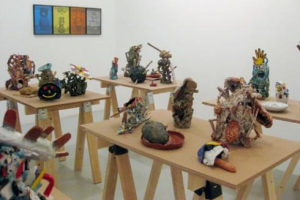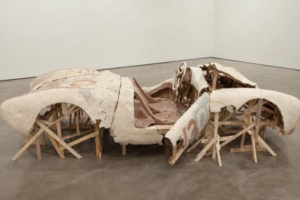Yoan Capote, a stand-out artist in the Havana scene, explained in a recent interview that he wants his work to remain relevant after the ‘political exoticism’ of Cuban art (fashionable since the mid-90s) dies down. In the meantime, his recent subject matter – the allures and disillusionment of migration – and his tendency towards often blunt, sometimes profound statements are the hallmarks of stereotypical Cuban style. Despite the feeling of déjà vu that this show evokes, Capote makes his mark by implicating everyone – us, himself, and Cubans in general – in the complex pleasures and pains of cross-cultural longing.
Capote opens the show with a literal bait-and-switch – a majestically vast (over 26 foot long) and gorgeously deserted seascape that turns out on closer inspection to be an intimidating composition made from thousands of fish hooks attached to the picture’s surface. An equally enticing sea view crops up again in a nearby video in which we watch a waterfront window being bricked in with the pattern of a U.S. flag in a claustrophobic ritual that replaces the imagined but unattainable reality of foreign lands beyond the horizon with a barricade both symbolic and literal.
Surprise menace and repressive restriction create an uneasy mood but leave room for personally inflected interpretation. More heavy-handed pieces kill the spirit of enquiry, as with a room-sized bronze set of scales titled ‘Status Quo (Reality and Idealism)’ that leaves no doubt about how privilege tips in favor of the already powerful. In a series titled ‘Coitus’, human silhouettes cut from dollar bills, pesos, rubles and Yuan play the one-dimensional role of symbolic aggressor or victim. But in pieces like ‘Migrant,’ in which two feet join to tree trunk legs that end in a complex network of roots, Capote pointedly testifies to the personal cost of uprootedness. Laid low on the gallery floor, roots echoing brain synapses make the poignant argument that when it comes to the linguistic, social or cultural nourishment of your native culture, you can’t take it with you.
Originally published in Flash Art International, issue 276, January/February, 2011.



